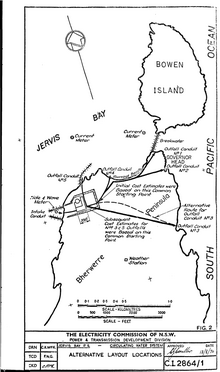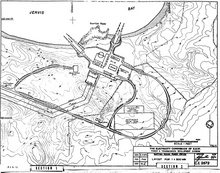| Jervis Bay Nuclear Power Plant | |
|---|---|
 East end of the proposed site of the Jervis Bay Nuclear Power Plant, 2014 East end of the proposed site of the Jervis Bay Nuclear Power Plant, 2014 | |
| Country | Australia |
| Location | Jervis Bay Territory |
| Coordinates | 35°07′34″S 150°45′11″E / 35.126°S 150.753°E / -35.126; 150.753 |
| Status | Cancelled |
| Decommission date |
|
| Owner | Government of New South Wales |
| Operator | The Electricity Commission of NSW (Elcom) |
| Nuclear power station | |
| Reactor type | Steam-Generating Heavy Water Reactor (SGHWR) |
| Reactor supplier | The Nuclear Power Group Ltd. (TNPG) |
| Cooling source | Jervis Bay, South Pacific Ocean |
| Power generation | |
| Units cancelled | 1 x 600 MWe |
| [edit on Wikidata] | |
The Jervis Bay Nuclear Power Plant was a proposed nuclear power reactor in the Jervis Bay Territory, an Australian federal territory adjoining the South Coast of the state of New South Wales. It would have been Australia's first nuclear power station, and is the only proposal to have received serious consideration by governments as of May 2023. Some environmental studies and site works were completed, and two rounds of tenders were called and evaluated, but the Australian Government ultimately decided not to proceed with the project, owing both to the perceived cost, and to the discovery of new mineral and hydrocarbon resources.
Background to the project
In 1969, the Australian government proposed to the New South Wales government that a 500 MWe nuclear power station should be built on Commonwealth territory and connected to the New South Wales grid, with electricity generation and distribution being a state responsibility under the Australian constitution. Possible sites were the Australian Capital Territory and Jervis Bay. The plan, supported by the Australian Atomic Energy Commission, was for a reactor design that could generate weapons-grade plutonium, possibly reflecting Australia's long-term post-World War II interest in acquiring nuclear weapons.
In December 1969, invitations to express interest in the construction of a nuclear power plant at Jervis Bay were sent to fourteen organisations. Tender documents were issued in February 1970, with tenders closing in June. Fourteen tenders were received, from seven different organisations. About 70 staff were involved full-time in evaluating tenders, principally from the Australian Atomic Energy Commission and the Electricity Commission of New South Wales. More than 150 other staff had a significant part-time role. As a result, a recommendation was written for the acceptance of a tender to supply a 600 MWe Steam generating heavy water reactor (SGHWR), from the British organisation, The Nuclear Power Group.


The abandonment of the proposal

Before this recommendation was made, there was a change of prime minister, although not of government. John Gorton had been a supporter of the project. In March 1971, Gorton was replaced as prime minister by William McMahon. McMahon opposed the nuclear power program, and the project was deferred for a year, citing financial constraints – Treasury prepared the first comprehensive comparative cost analysis in 1971 and concluded that nuclear was going to be far more expensive than a conventional coal plant.
Following the discovery of natural gas and oil in Bass Strait, and the development of economic coal resources, most of the energy security incentive had evaporated. Tenders were re-called, only to be again deferred and in practical terms cancelled in June 1971. Organisations like the World Union for Protection of Life, the Ecology Action and the Society for Responsibility in Science had reported about the dangers connected with the nuclear power plant.
Some land clearing was done in preparation for the construction, and concrete footings were installed. The footings are visible to this day.
See also
- High Flux Australian Reactor - Australia's first nuclear reactor
- Nuclear power in Australia
References
- Cawte, Alice (1992), Atomic Australia : 1944-1990, NSW University Press, ISBN 978-0-86840-388-5, OCLC 647065941
- Holland, Ian (2003). "Radioactive Waste and Spent Nuclear Fuel Management in Australia". Chronology. Department of the Parliamentary Library. p. 9. No. 1 2003–04.
- "ParlInfo - Radioactive waste and spent nuclear fuel management in Australia". parlinfo.aph.gov.au. Retrieved 27 May 2019.
- Alder, Keith (1996). Australia's Uranium Opportunities. Sydney: Pauline Alder. ISBN 0-646-29942-5. OCLC 38410139.
- Hancock, Ian (2002). John Gorton: He Did It His Way. Hodder. ISBN 0-7336-1439-6. OCLC 49763995.
- "Gorton gave nod to nuclear power plant". The Age. 1 January 2000.
- "Classic stoush the sub-text to nuclear plan". The Canberra Times. 1 January 2000.
- "Letter from Harry F. Kurth, World Union for Protection of Life". The Joshua Lederberg Papers. National Library of Medicine. 8 April 1972.
Further reading
- Australian Academy of Science, Society for Social Responsibility in Science. (A.C.T.); Australian Atomic Energy Commission (1972). Symposium papers on the role of nuclear energy in Australia's development, June 1st and 2nd, 1972. Australian Academy of Science. p. 220. ISBN 0-85847-012-8. OCLC 707806.
- Reynolds, Wayne (2000). Australia's Bid for the Atomic Bomb. Melbourne University Press. p. 284. ISBN 0-522-84914-8. OCLC 46880369.
External links
| Jervis Bay Territory, Australia | |
|---|---|
| Villages | |
| Places of interest | |
| Others | |
